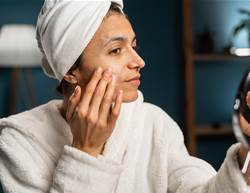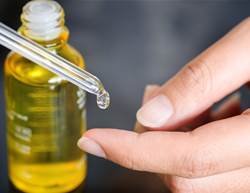Using the best retinol creams and serums, eye creams and moisturisers are all essential for a healthy-looking complexion. But knowing how to exfoliate your face can help you achieve even brighter, smoother skin.
Exfoliating is the process of removing dead skin cells, explains dermatologist Dr Marisa Garshick. There are two types of exfoliation—chemical and physical—and both work to “eliminate the build-up of dead skin cells, leaving the skin looking brighter and more radiant while feeling softer and smoother,” she says.
Exfoliating doesn’t just make your skin look fresher—it also unclogs pores, helps prevent breakouts and even encourages collagen production for firmer, more youthful skin, explains double-board certified dermatologist Dr Brendan Camp.
Here’s everything you need to know about how to exfoliate your skin properly.
Types of exfoliation
Experts say there are two main types of exfoliants: physical and chemical.
Physical: Physical exfoliation mechanically buffs away dead skin cells using tiny particles. “These may contain sugar, salt, or ground coffee,” explains Dr Camp. “They work by physically sloughing off dead skin and accelerating the body’s natural exfoliation process.” Dry brushing is another form of physical exfoliation.
Chemical: Chemical exfoliation uses acids or enzymes to break the bonds between dead skin cells, allowing them to shed more easily. “These exfoliants tend to come in liquid, serum or powder form,” says Dr Camp. Common chemical exfoliants include alpha hydroxy acids (AHAs) such as glycolic acid, lactic acid or mandelic acid or beta hydroxy acids (BHAs) like salicylic acid, explains Dr Garshick. He notes that AHAs are great for brightening and improving skin texture, while BHAs penetrate deeper into pores, making them ideal for oily and acne-prone skin.
How to exfoliate your face
The right exfoliation method depends on your skin type and the product you’re using, says dermatologist Dr Janiene Luke.“For liquid exfoliants, you can use a cotton round or cotton ball to apply the product. Cleansers or leave-on products may also have exfoliating ingredients...and may be applied and washed off or applied to the skin and left on the skin respectively,” she says. “For [physical] exfoliants, you can apply them using your hands/fingers and manually rub them into the skin using a circular motion.”
It’s important to note how exfoliating fits into your skincare routine order. Dr Garshick says it’s best to avoid exfoliating when using products with “other harsh active ingredients, such as benzoyl peroxide or retinoids.”
Ahead, our experts explain how to exfoliate:
- Wash your face. “It is best to apply to clean skin,” Dr Garshick says.
- Exfoliate. Whether that means applying a gentle scrub or using a chemical exfoliant (aka A serum or powder) is up to you. Follow the product’s directions and be sure to test any chemical exfoliant on a small patch of skin before applying it all over to see how your skin reacts.
- Moisturize. “After exfoliating, it is important to apply a gentle moisturiser to help soothe and nourish the skin,” says Dr Garshick.
What type of exfoliant should I use based on my skin type?
Dr Garshick urges those with sensitive or rosacea-prone skin to use caution when exfoliating. That said, here’s how to figure out the best exfoliant for your skin type.
Sensitive and dry: “Generally, for those with dry or sensitive skin, it is best to opt for a chemical exfoliant, as physical exfoliants may be too harsh and abrasive on the skin,” Dr Garshick says.
Oily: “Those with oily skin may find salicylic acid, a type of chemical exfoliant, to help unclog the pores in addition to helping with exfoliation,” she says.
Combination: Those with normal or combination skin may be able to do either chemical or physical exfoliation, Garshick says, but regardless of the type of exfoliation, it is important to avoid over-exfoliation. Dr Camp says signs of over-exfoliating consist of “redness, irritation and potentially rashes or skin breakdown.”
Who shouldn’t exfoliate?
“This may depend on the ingredients that are in the exfoliant,” explains Dr Luke, “but in general, people with sensitive skin or skin conditions that are associated with skin sensitivity or an impaired skin barrier (such as atopic dermatitis or rosacea) should avoid exfoliation or try a test area prior to using it on the face.”
While Dr Garshick says technically anyone can exfoliate, there are some who may want to skip both the physical and chemical versions. Dr. Camp agrees, “People with active skin infections or recently flared skin conditions like eczema or rosacea should pause exfoliation until the skin has recovered.”
How often should I exfoliate my face?
The general recommendation for exfoliation frequency is two to three times a week, says Dr Camp. Dr Garshick takes a slightly more conservative approach: “In general, it is best to exfoliate one-to-two times per week.”
She says to keep in mind that “it is important to avoid exfoliating too often or too vigorously as this can disrupt the skin barrier and lead to microtrauma in the skin, leading to dryness, irritation and sensitivity.”
Exfoliants to use
Our experts suggest the below chemical exfoliants. Just be sure you identify the type of exfoliant that’s best for your skin before applying.
Should I exfoliate with wet or dry skin?
It depends on the type of exfoliant you’re using, Dr Garshick says. “In some cases, such as with scrubs, it is best for the skin to be damp, while many exfoliants are intended to be used on dry skin, such as exfoliating toners or serums or certain physical exfoliants like dry brushing.”










